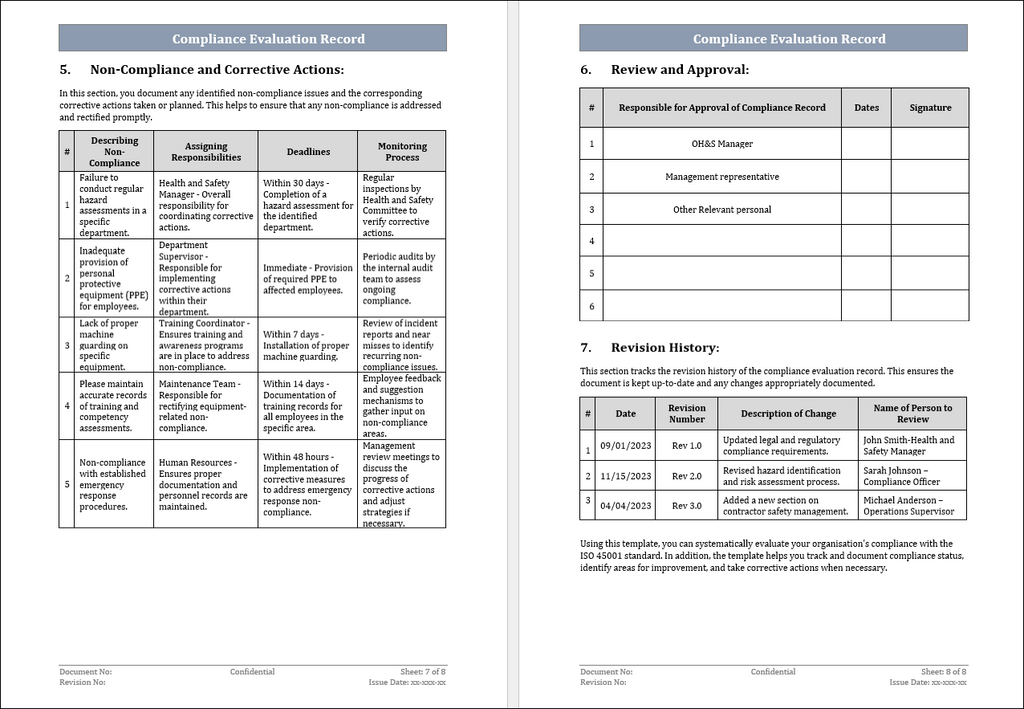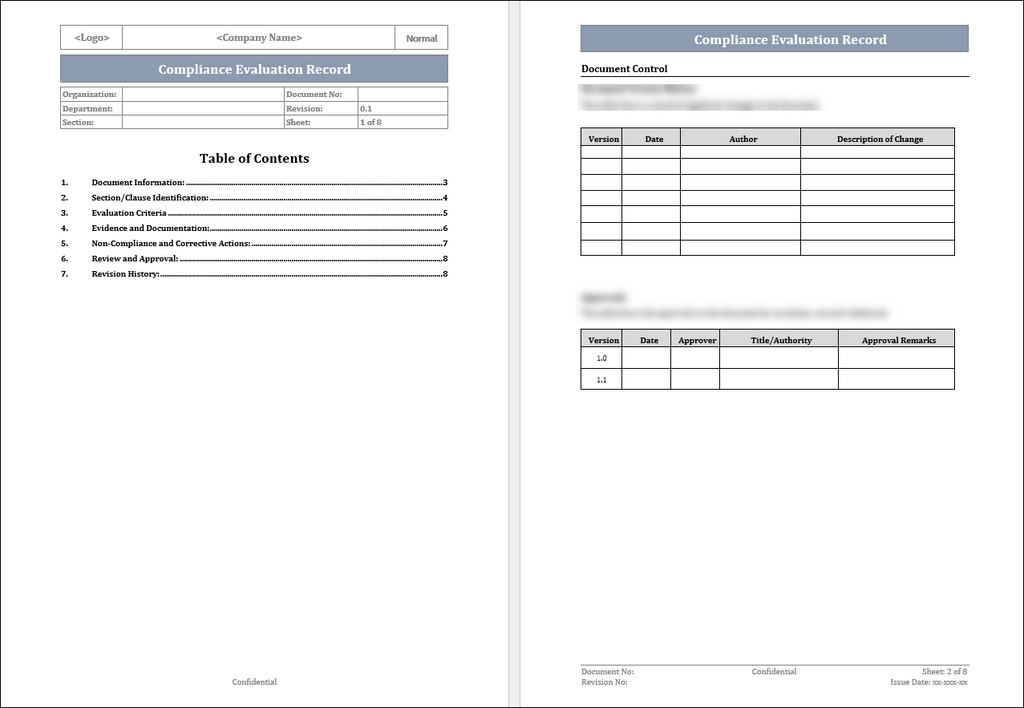ISO 45001 Compliance Evaluation Record Template
Introduction
Compliance evaluation is a crucial aspect of maintaining standards and ensuring the effectiveness of management systems. A comprehensive compliance evaluation record template is essential for organizations looking to comply with ISO 45001. This template serves as a structured tool for assessing an organization's compliance with the requirements of the ISO 45001 standard. By using this template, organizations can systematically evaluate their compliance status, identify gaps or areas of improvement, and implement appropriate corrective actions. In this blog, we will explore the importance of compliance evaluation, the critical components of a compliance evaluation record for ISO 45001, and how organizations can use this template to enhance their occupational health and safety management systems.

Importance Of Compliance Evaluation For ISO 45001
Compliance evaluation is of utmost importance regarding ISO 45001, the international standard for occupational health and safety management systems. This evaluation ensures that organizations adhere to the requirements and regulations set forth by ISO 45001, creating a safe and healthy work environment for employees. Compliance evaluation ensures that the organization meets the legal requirements and obligations related to workplace safety. It ensures that all necessary permits, licenses, and certifications are in place and current.
By complying with legal requirements, organizations protect their employees and mitigate the risk of facing legal consequences and financial penalties. Furthermore, compliance evaluation helps organizations identify and assess any existing or potential hazards in the workplace. This evaluation allows organizations to implement necessary control measures to prevent accidents, injuries, and illnesses. By addressing these hazards proactively, organizations can reduce the number of workplace incidents, safeguard their employees' well-being, and reduce the associated costs such as medical expenses and compensation claims.
Compliance evaluation also aids in identifying any gaps or weaknesses in the organization's occupational health and safety management system. By evaluating whether the system aligns with ISO 45001 requirements, organizations can improve their processes, policies, and procedures to enhance overall safety performance. This evaluation allows organizations to continuously monitor and measure their compliance levels, enabling them to make informed decisions to improve their safety management system.
Evaluating And Improving Your Communication And Awareness Plan
1. Complexity Of Regulations: One major challenge in conducting a compliance evaluation is the complexity of regulations. Regulations are often legal jargon, making it difficult for non-legal professionals to understand and interpret them accurately. To overcome this challenge, it is essential to thoroughly study and analyze the regulations to ensure a proper understanding.
2. Lack Of Resources: Conducting a compliance evaluation requires a significant amount of resources, including personnel, time, and financial resources. The limited availability of these resources can pose a challenge in carrying out a comprehensive evaluation. To address this challenge, proper allocation of resources, strategic planning, and prioritization of high-risk areas can help overcome resource constraints.
3. Resistance From Stakeholders: Another challenge faced during compliance evaluations is the resistance from stakeholders, such as employees, managers, or third-party vendors, who may perceive the evaluation process as intrusive or disruptive to their work. To overcome this challenge, effective communication and stakeholder engagement are vital. Explaining the purpose of the evaluation, providing regular updates, and ensuring transparency can help alleviate resistance and build cooperation.
4. Changing Regulatory Landscape: Regulatory requirements are not static and are subject to frequent changes. Staying up-to-date with evolving regulations and incorporating them into compliance evaluations is a constant challenge. Overcoming this challenge requires ongoing monitoring and communication with regulatory bodies, industry associations, and professional networks to stay abreast of any changes or updates. Regular training and professional development for the evaluation team can also help enhance their knowledge and understanding of new regulations.
5. Data Collection And Analysis: Gathering and analyzing relevant data to assess compliance can be time-consuming and complex. Accessing accurate and reliable data, lack of standardized data collection methods, or incomplete data can help the evaluation process. Overcoming this challenge involves establishing robust data collection procedures, ensuring data integrity, employing appropriate data analysis tools, and utilizing technology solutions to streamline the process.
6. Managing Organizational Culture: Evaluating compliance may involve identifying and addressing cultural issues. Resistance, lack of awareness, or a "tick-box" mentality can undermine the effectiveness and credibility of compliance evaluations. Overcoming this challenge requires a proactive approach to organizational culture, including promoting a culture of ethics and compliance, implementing regular training and awareness programs, and fostering open communication channels.

Benefits Of Using The ISO 45001 Compliance Evaluation Record
1. Standardization: ISO 45001 Compliance Evaluation Record provides a standardized framework for evaluating compliance with the Occupational Health and Safety Management System (OHSMS) requirements. This ensures that all organizations follow the same assessment criteria and can be easily compared.
2. Identified Gaps: The evaluation record helps identify gaps or non-compliance with the ISO 45001 standard. This allows organizations to take corrective actions and implement necessary measures to ensure compliance and prevent accidents or occupational hazards.
3. Continual Improvement: By regularly evaluating compliance with ISO 45001 requirements, organizations can identify areas for improvement. This promotes a culture of continuous improvement and helps enhance the effectiveness of the OHSMS.
4. Enhanced Health And Safety Standards: ISO 45001 Compliance Evaluation Record helps organizations assess their compliance with the ISO 45001 standard, specifically designed for occupational health and safety management systems. By using this record, companies can ensure that their health and safety standards are up to par, leading to a safer and healthier work environment for employees.
5. Improved Risk Assessment: The compliance evaluation record allows organizations to identify potential health and safety hazards in the workplace. By conducting a proper evaluation, companies can assess risks and implement adequate controls to mitigate those risks. This proactive approach helps prevent accidents or incidents and minimizes the negative impact on employees and the business.
6. Legal Compliance: ISO 45001 compliance is often a legal requirement for organizations, depending on the industry and country. Organizations can use the compliance evaluation record to demonstrate their commitment to meeting legal requirements and industry regulations, thus avoiding penalties or legal issues.
Conclusion
In summary, the Compliance Evaluation Record concerning the ISO 45001 Template is essential for organizations seeking to assess their compliance with ISO 45001 standards. This template provides a comprehensive framework for evaluating and documenting the results. By utilizing this template, organizations can ensure that they meet the requirements and identify areas for improvement. Please visit our website to download the Compliance Evaluation Record concerning the ISO 45001 Template.


